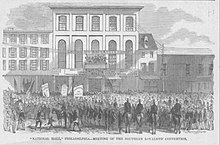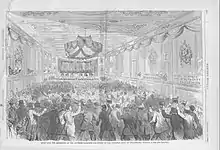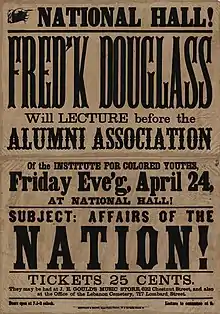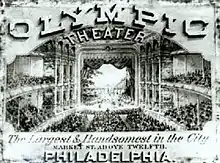

National Hall is a former venue in Philadelphia, Pennsylvania, located at 1222–24 Market Street, between Twelfth and Thirteenth Streets. It was one of the most popular venues in the city, site of concerts, lectures, meetings, and political speeches. It opened on January 8, 1856, with a "grand operatic concert".[1] While it existed, from 1856 to 1873, it was the main venue in Philadelphia for speakers for abolitionism and other progressive causes.
Some meetings held in National Hall

- The 1856 American National Convention was held there.
- In 1857, John W. Forney presided over a meeting to protest President Buchanan's attempt to impose the pro-slavery Lecompton Constitution on the Kansas Territory.[2]: 727
- In December 1859 abolitionists held an extended vigil awaiting John Brown's execution, and afterwards continued with memorials.[3]
- On January 5, 1861, a meeting of support was held for Major Robert Anderson, besieged at Fort Sumter.[2]: 743–745
- On March 2, 1862, a meeting was held "to take into consideration the colored people of Beaufort, S.C., who were suffering for food and clothing."[2]: 795
- In November, 1862, it was fitted out as a circus, and opened by Gardner & Hemmings.[2]: 980
- On April 24, 1863, Frederick Douglass lectured on "Affairs of the Nation" (see poster at right).
- On January 2, 1865, Octavius Catto addressed a gathering celebrating the second anniversary of the Emancipation Proclamation.[4]
- In the spring of 1866 the Fenian Brotherhood held a meeting, and such meetings were common for the next few years.[2]: 834
- Frederick Douglass spoke there to a group of Southern loyalists (opposed to secession) on September 3, 1866.[5][2]: 833 In Harper's Magazine there is a lengthy report on this meeting.[6]
- In October 1871, a mass meeting expressed outrage at the election-day killing of Octavius Catto.[2]: 837
Olympic Theater

In 1873 it was turned into a theatre by J. H. Johnson & Co., and opened October 21st, under the name of the Olympic Theater.[2]: 980
The Theater was destroyed by fire on January 29, 1874. The cause is not known, but arson was suspected. Two firemen were killed when a wall of the burning building collapsed on them. It was valued at $60,000 (equivalent to $1,551,882 in 2022).[7][8]
See also
References
- ↑ "Musical Union. Grand Opening of the National Hall". Public Ledger (Philadelphia, Pennsylvania). January 8, 1856. p. 3. Archived from the original on 2021-01-08. Retrieved 2020-12-22 – via newspapers.com.
- 1 2 3 4 5 6 7 8 Scharf, John T; Westcott, Thompson (1884). History of Philadelphia : 1609-1884. Vol. 2. Philadelphia: L. H. Everts.
- ↑ Venet, Wendy Hamand (1995). "'Cry Aloud and Spare Not': Northern Antislavery Women and John Brown's Raid". In Finkleman, Paul (ed.). His Soul Goes Marching On. Responses to John Brown and the Harpers Ferry Raid. Charlottesville, Virginia: University Press of Virginia. pp. 98–115, at pp. 100–101. ISBN 0813915368.
- ↑ Christian Recorder, January 7, 1865.
- ↑ "Frederick Douglass Havre de Grace and Philadelphia Sites". Ordinary Philosophy. April 3, 2016. Retrieved December 20, 2020.
- ↑ Hapgood, Norman; Harvey, George Brinton Mcclellan; Bangs, John Kendrick; Nelson, Henry Loomis; Schurz, Carl; Davis, Richard Harding; Foord, John; Schuyler, Montgomery; Conant, Samuel Stillman; Alden, Henry Mills; Curtis, George William; Bonner, John (September 22, 1866). "The Last Philadelphia Convention. The Loyalist Convention". Harper's Weekly: 594 and 598.
- ↑ "Olympic Theater Destroyed". Philadelphia Inquirer (Philadelphia, Pennsylvania). January 30, 1874. p. 2 – via newspapers.com.
- ↑ "Disastrous fire in Philadelphia". Harrisburg Telegraph (Harrisburg, Pennsylvania). January 29, 1874. p. 2 – via newspapers.com.